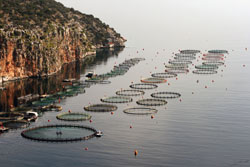Fingerprinting fish farms for antibiotic resistance
Antibiotic resistance in microbes is a widely reported problem. In particular, multi-resistant strains pose a serious threat to public health. Unfortunately, the source of this resistance is partly due to overuse and inappropriate prescription of antibiotics. Moreover, once a bacterium is resistant, it is possible to pass on the genes responsible to other bacteria during a process known as conjugation. The aquaculture industry in South East Asia is a thriving concern. Unfortunately, due to the constant threat of infection in a mono-cultural situation, the use of antimicrobials is very common. The EU-funded project ASIARESIST therefore set out to assess the risk of transferable resistance from fish farms in this region. At the Aquatic Animal Health Unit in the University of Putra, Malaysia, the project partners aimed to genotype bacteria for resistance to the antibiotics chloramphenicol, streptomycin and sulphonamide. The key difference in the investigation was that instead of susceptibility testing, a genotypic approach was used whereby the presence of resistance genes was determined. The repetitive polymerase chain reaction (rep-PCR) technique was utilised to amplify the DNA from some 140 bacterial isolates from selected fish farms. Specific (GTG)5 primers for the amplification of specific sequences of DNA for analysis were used. The results of the amplification were then subjected to electrophoresis and UV-fluorescence after staining. The resultant (GTG)5 fingerprints were analysed with GelCompare software. Once in the realms of genetic fingerprinting, the actual mechanisms of resistance can be elucidated. Analysis for the mechanism of chloramphenicol resistance was performed and whether resistance to more than one antibiotic was transferred at the same time (trans-conjugation). This was observed to be the case for chloramphenicol and sulphonamide resistance. Moreover, whether the isolate is multi-resistant and therefore the level of threat to health could be determined. The process was found to be very effective at differentiating strains of bacteria. This makes it feasible to track established and newly evolved pathogens and to apply appropriate hazard control strategies to avoid a food or environmental safety threat. Moreover, it is a rapid, robust, sensitive and cost-effective method for identification of genetic resistance.







